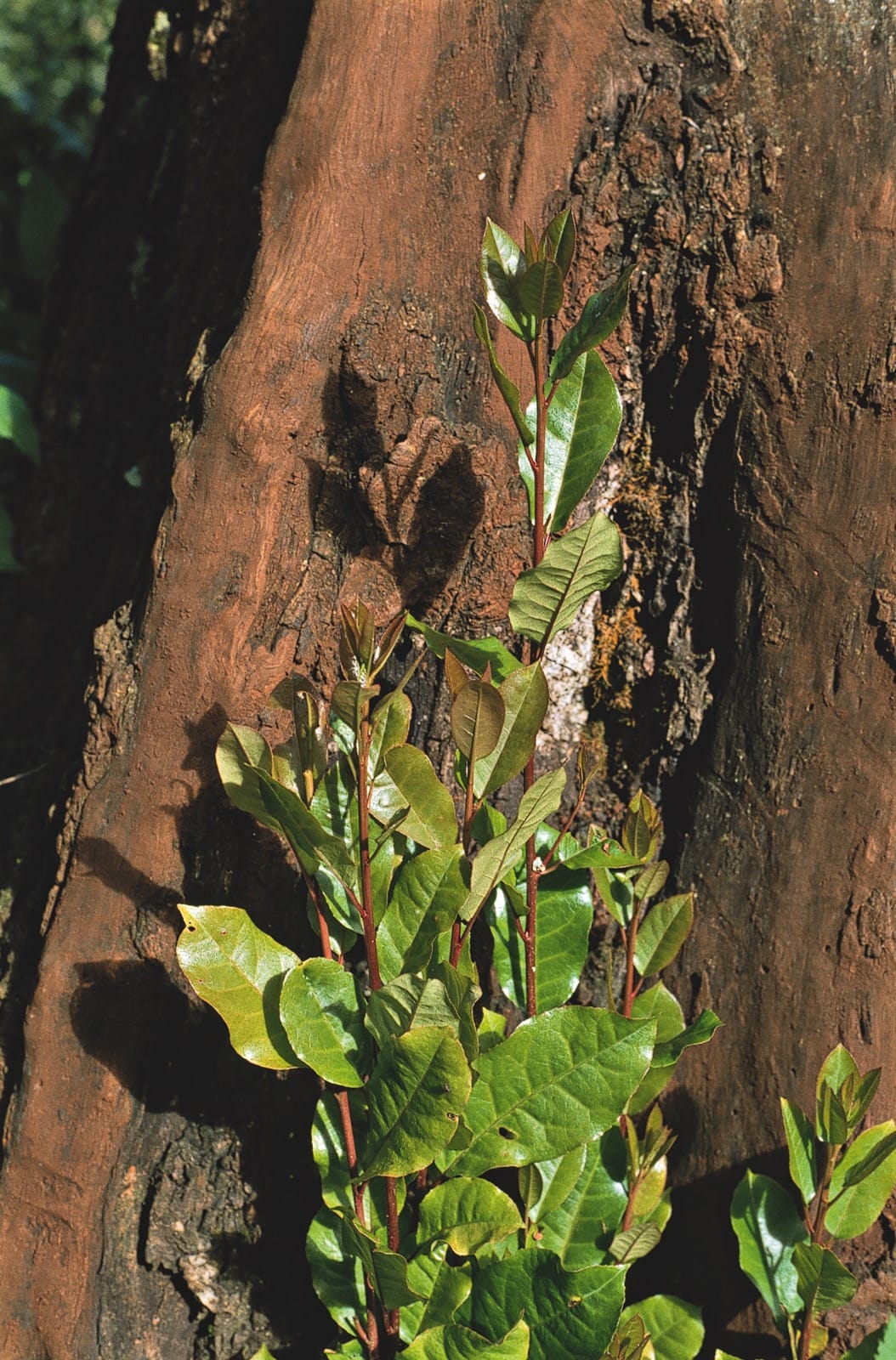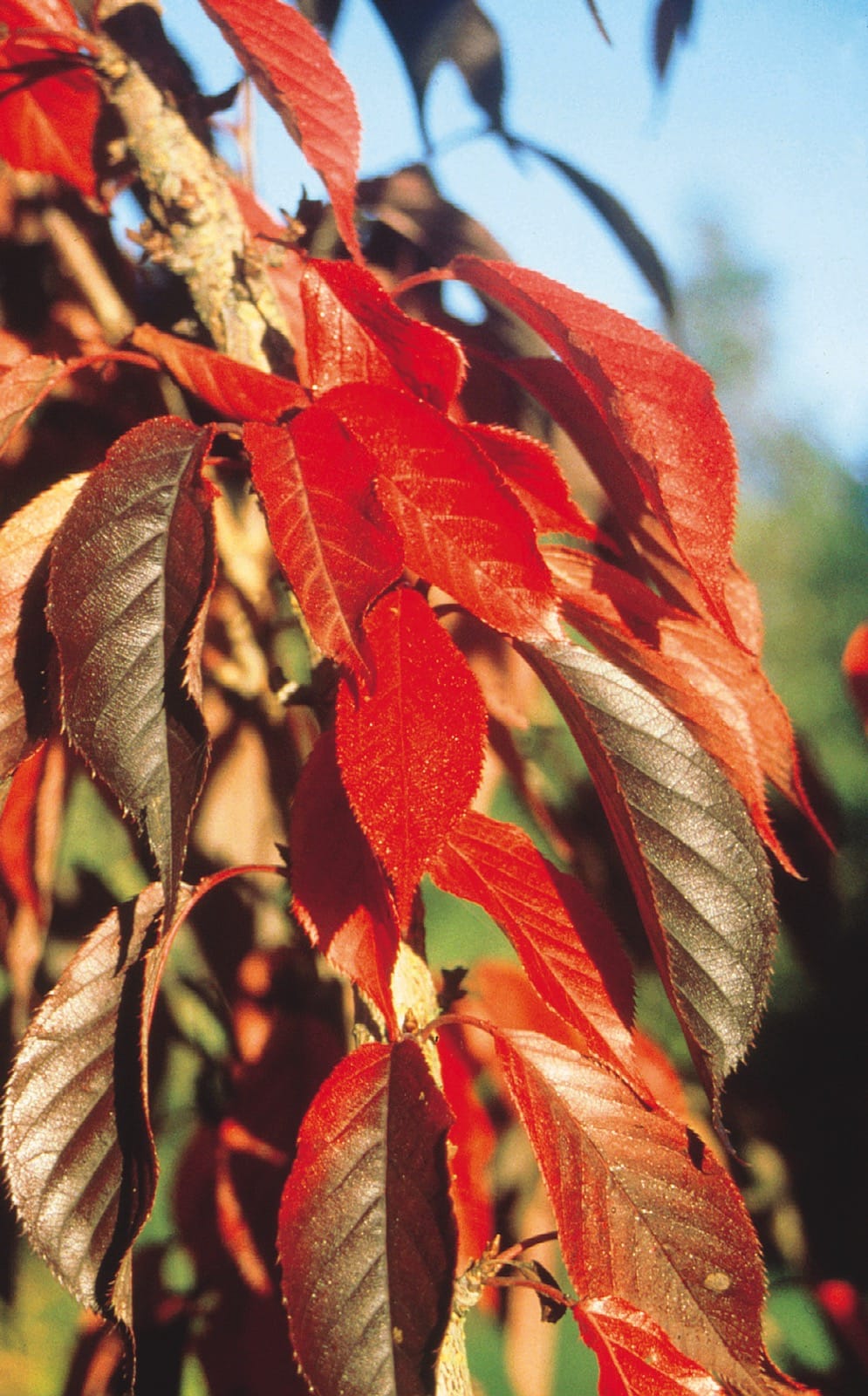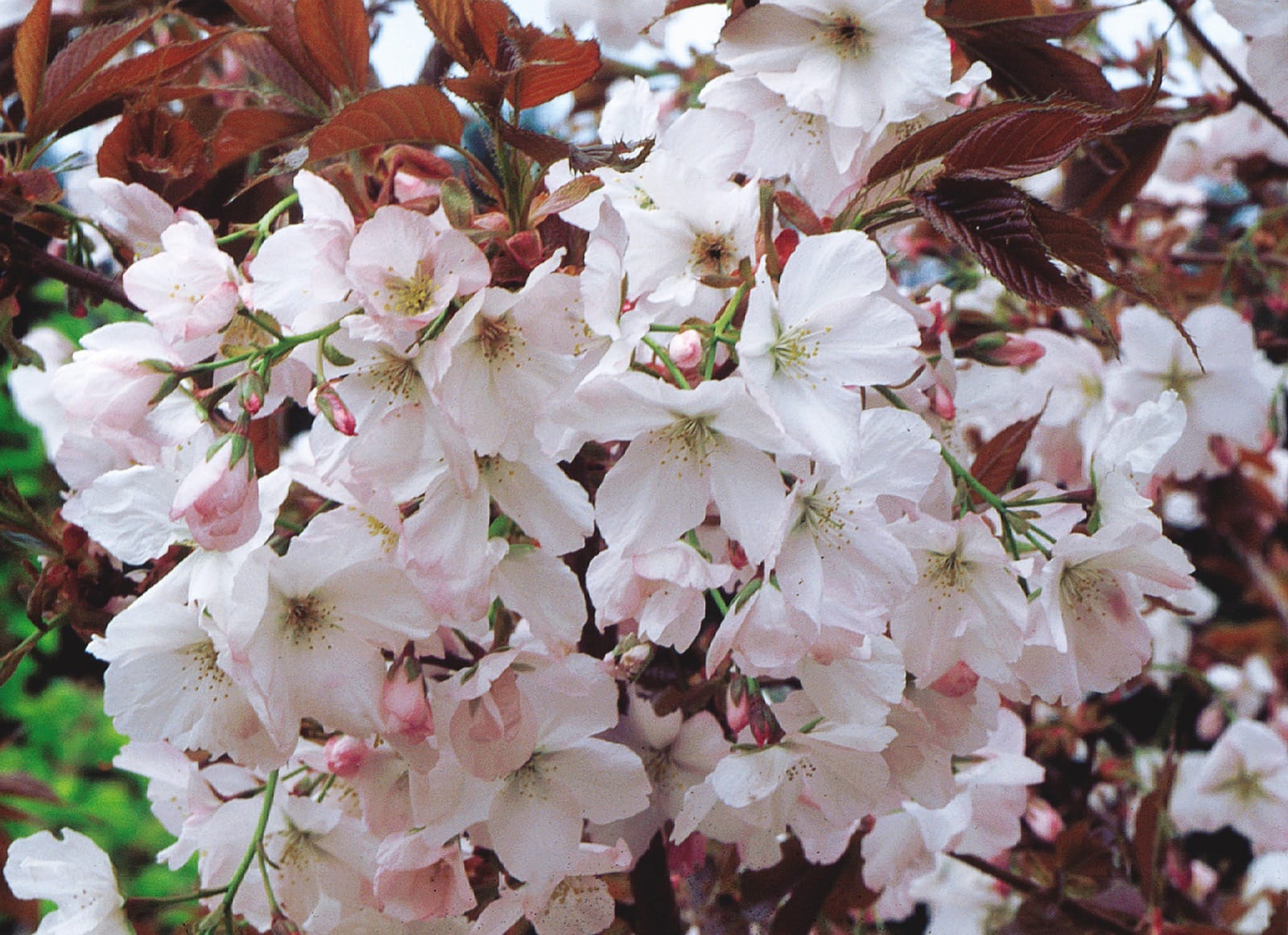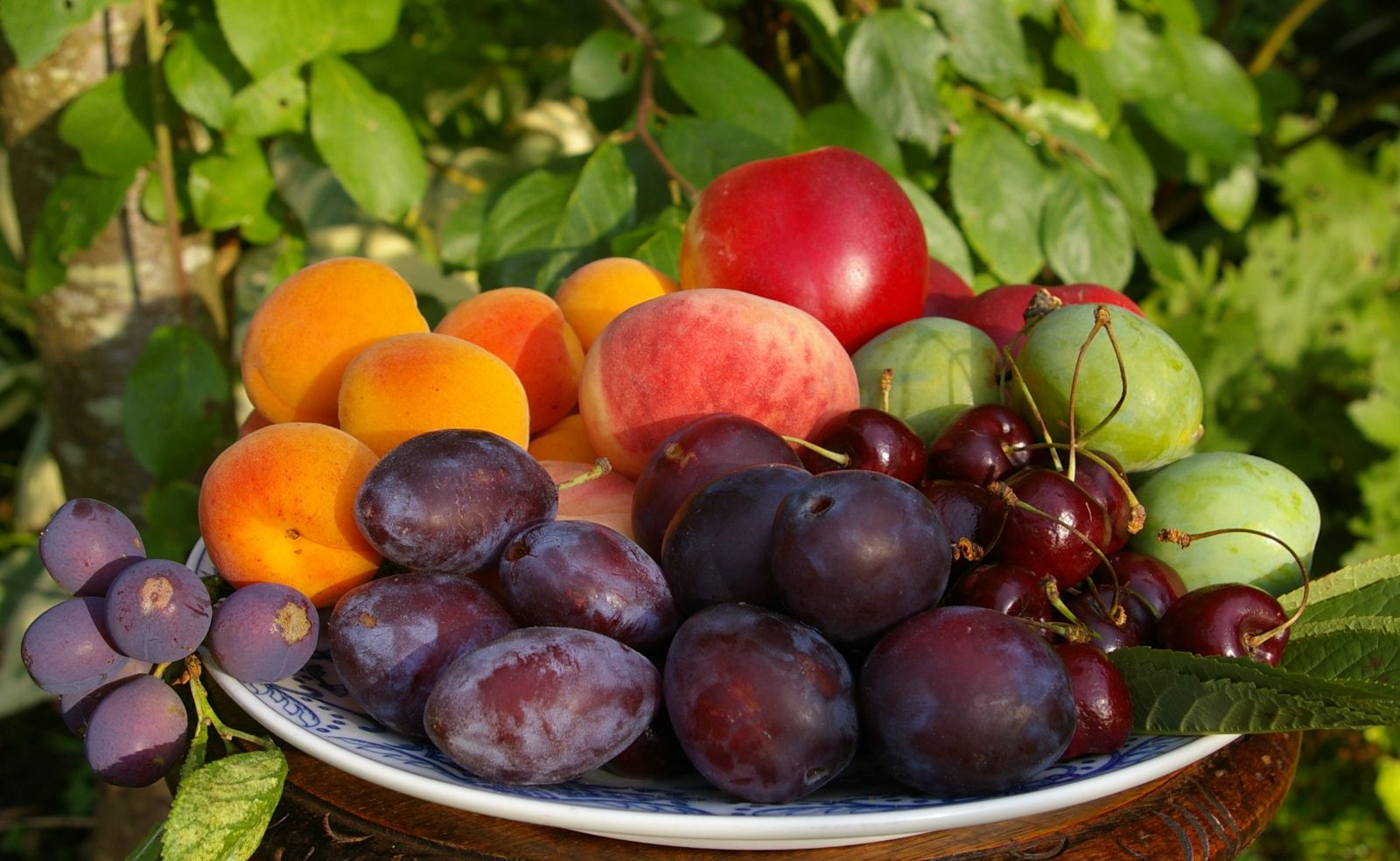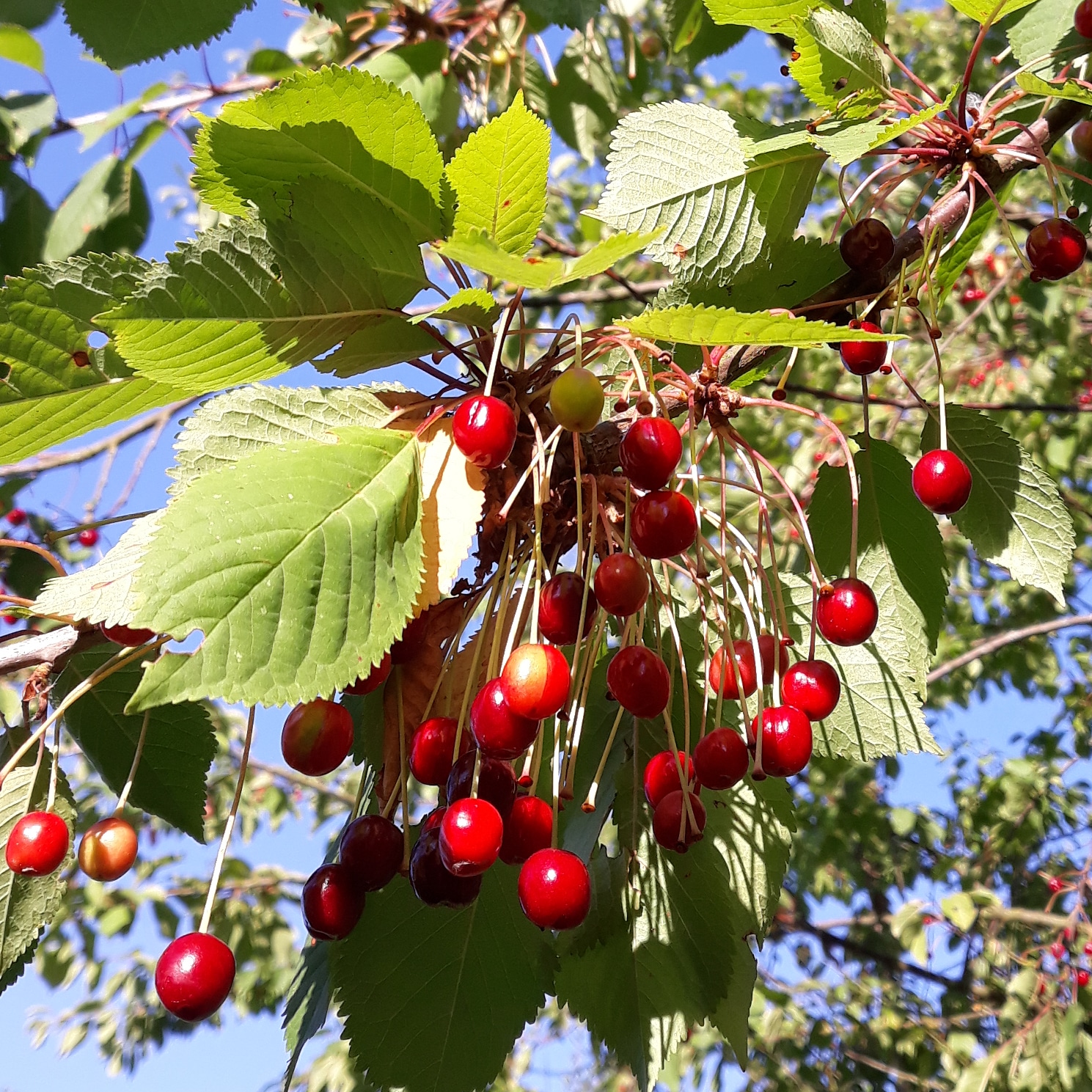Prunus
Credits
Article from Bean's Trees and Shrubs Hardy in the British Isles
Article from New Trees by John Grimshaw & Ross Bayton
Recommended citation
'Prunus' from the website Trees and Shrubs Online (treesandshrubsonline.
Family
- Rosaceae
Common Names
- Almonds
- Apricots
- Bird-cherries
- Cherries
- Gages
- Peaches
- Plums
Synonyms
- Amygdalus L.
- Armeniaca Scop.
- Cerasus Mill.
- Laurocerasus Duham.
- Padus Mill.
- Persica Mill.
- Pygeum Gaertn.
Species in genus
- Prunus alleghaniensis
- Prunus americana
- Prunus × amygdalo-persica
- Prunus amygdalus
- Prunus angustifolia
- Prunus apetala
- Prunus arabica
- Prunus argentea
- Prunus armeniaca
- Prunus avium
- Prunus besseyi
- Prunus brigantina
- Prunus campanulata
- Prunus canescens
- Prunus cantabrigiensis
- Prunus cerasifera
- Prunus cerasus
- Prunus cocomilia
- Prunus concinna
- Prunus conradinae
- Prunus consociiflora
- Prunus cornuta
- Prunus cuthbertii
- Prunus dasycarpa
- Prunus davidiana
- Prunus × dawyckensis
- Prunus dielsiana
- Prunus domestica
- Prunus dulcis
- Prunus emarginata
- Prunus × fontanesiana
- Prunus fruticosa
- Prunus glandulosa
- Prunus grayana
- Prunus himalaica
- Prunus hortulana
- Prunus humilis
- Prunus ilicifolia
- Prunus incana
- Prunus incisa
- Prunus jacquemontii
- Prunus kansuensis
- Prunus lannesiana
- Prunus laurocerasus
- Prunus litigiosa
- Prunus lusitanica
- Prunus maackii
- Prunus mahaleb
- Prunus maritima
- Prunus maximowiczii
- Prunus microcarpa
- Prunus mira
- Prunus mugus
- Prunus mume
- Prunus nigra
- Prunus nipponica
- Prunus orthosepala
- Prunus padus
- Prunus pensylvanica
- Prunus persica
- Prunus pilosiuscula
- Prunus prostrata
- Prunus pumila
- Prunus rufa
- Prunus salicina
- Prunus sargentii
- Prunus serotina
- Prunus serrula
- Prunus serrulata
- Prunus sibirica
- Prunus × sieboldii
- Prunus simonii
- Prunus sogdiana
- Prunus speciosa
- Prunus spinosa
- Prunus ssiori
- Prunus subcordata
- Prunus subhirtella
- Prunus takesimensis
- Prunus tangutica
- Prunus tenella
- Prunus tomentosa
- Prunus triloba
- Prunus virginiana
- Prunus × yedoensis
There are over 200 species of Prunus, most of which occur in the temperate northern hemisphere. While Prunus has in the past been divided into numerous segregate genera, DNA evidence suggests that the segregates are better recombined into a single genus (Bortiri et al. 2001), and that approach has been used here. Prunus species are shrubs or trees with deciduous or rarely evergreen leaves; they are usually unarmed, though thorns occur in some species (for example, P. spinosa, Blackthorn). The leaves are simple and alternate with entire, serrate or crenate margins; glands are usually present on the margins, or on the underside of the lamina, or as a pair on the petiole. Stipules are usually caducous. The inflorescence is basically a raceme and is usually unbranched; it may be reduced to a few-flowered umbel or to only a single flower (or pair of flowers). The flowers are hermaphrodite, 5-merous and either white or pink; the hypanthium is tubular or bowl-shaped and usually falls, with the sepals, before the fruit forms; the petals are inserted at the mouth of the hypanthium; stamens 10 to numerous. The fruit is a drupe with juicy or rather dry flesh and is indehiscent (dehiscent in the Almond P. dulcis). Each fruit contains a woody or bony stone (endocarp) with a smooth or rugged exterior; the stone is indehiscent or has two valves, and contains a single seed (the pit) (Mendes 1978, Elias 1980, Ohashi 1993a, Kalkman 2004).
As so often is the case where a genus contains species that are edible and (or) ornamental, nomenclature within Prunus is as tangled as a Blackthorn hedge. Dismemberment of the genus at different times into segregates has contributed an excess of synonyms, and the ornamental cherries, especially in Japan, have added many more names to the register. Conveniently, however, there is a helpful website entitled ‘Sorting Prunus Names’ (University of Melbourne 1995–2020) and describing itself (accurately) as a ‘multilingual, multi-script plant name database’, that gives a synoptic account of Prunus nomenclature, enabling entities to be tracked down within the thicket of botanical names. Vernacular names are also provided, in appropriate scripts: for example, names are given in 25 languages for the edible Plum (P. domestica), including the Zulu umplaamuzi (try saying it). Cultivars are not covered, however, and there are many omissions (for example, P. himalaica, P. sogdiana, P. takesimensis: see accounts below).
Prunus, in all its manifestations, is one of the most important genera of ornamental and culinary trees. Most fall outside the remit of this account, which as always focuses on wild species, but it is undoubtedly the Japanese flowering cherries (Sato-sakura) that are the most popular and conspicuous ornamental Prunus taxa in cultivation, and several books dealing with this group are available (for example, Ingram 1948, Kuitert 1999, in addition to works in Japanese). New cultivars continue to be introduced in all groups within the genus, but it is the flowering cherries that receive most attention.
While working for Bridgemere Nurseries, Cheshire, Chris Sanders trialled an extensive array of new Japanese cherry cultivars raised in the 1960s by Masatoshi Asari, a schoolteacher from the town of Matsumae in Hokkaido, and has kindly provided notes on some of the most outstanding and distinctive. All Asari’s cultivar names were prefixed ‘Matsumae’ by the raiser, but recent Japanese accounts have omitted this in some cases (though not in all). Some have also been given selling names, which may vary in different countries. ‘Matsumae-beni-yutaka’ (syn. ‘Beni-yutaka’, introduced to the trade in 1961) is very early-flowering, with large semi-double pink flowers. It has an upright vase-shape when young but broadens with age, and is notable for its superb autumn colours. A little later in the season comes ‘Matsumae-usugasanesomei’ (1966), a hybrid of P. × yedoensis and equally floriferous, with small to medium-sized clear pink flowers, that are usually single but may have a few extra petaloids. This will form a sparsely branched, round-headed, small tree. Of mid-season cultivars, ‘Matsumae-benigasa’ (syn. ‘Benigasa’, 1961) has large, fully double flowers, opening pale pink but fading to white, among bronze-green leaves on a broad, spreading tree. ‘Matsumae-fuki’ (sold in the United Kingdom as Chocolate Ice, 1961) is also mid-season but forms a more upright tree. It produces very large, more or less single flowers (up to 6.5 cm diameter) that open pale blush to almost white from pink buds. The young leaves are deep coppery bronze and appear with the flowers. ‘Matsumae-hanagasa’ (syn. ‘Hanagasa’, sold in the United Kingdom as Pink Parasol, 1963) has a spreading to pendulous habit and produces large, double, pale pink flowers with a conspicuous bunch of bright green, phylloid styles in the centre. The bronze young leaves emerge at the same time as the flowers. The same is true of the foliage of ‘Matsumae-shizuka’ (syn. ‘Shizuka’, sold in the United Kingdom as Fragrant Cloud, 1960), but this more upright tree has large, pure white flowers that are semi-double and strongly scented of vanilla.
Mention should also be made of Prunus ‘Royal Burgundy’, propagated from a bud mutation found on a seedling of P. ‘Kanzan’ by Frank Parks of Speer & Sons Nursery, Woodburn, Oregon. This was introduced to the trade in the United States around 1990 and in the United Kingdom in 1999. The flowers are similar to those of ‘Kanzan’, but are a slightly darker magenta-pink and appear about a week later. The leaves are a striking dark reddish purple and the branches, stems and calyx are also reddish.
In addition to cultivar names for flowering cherries not known by any other name, mostly derived from P. serrulata, there are a number of nothospecific names coined by Japanese botanists to cover hybrid groups within which cultivars have been selected. These names may appear in the literature or in catalogues. For example, P. ×kanzakura Makino (the hybrid between P. cerasoides var. campanulata (Maxim.) Koidz. and P. jamasakura) includes several named cultivars, including ‘Kanzakura’, ‘Usu-kan-zakura’ and ‘Atami-zakura’ (Botanic Garden 2001–2008), which might appear in lists as stand-alone cultivars. Another such nothospecies, P. ×kobuku-zakura Ohwi (P. × subhirtella × P. pseudocerasus), with small white, semi-double flowers, is in cultivation in the United Kingdom. The plethora of Prunus names means that it is always likely that new ‘species’ will appear in lists.
A particularly interesting species, cultivated as an ornamental in California and South Africa, is P. africana (Hook. f.) Kalkman, a large evergreen tree from the montane forests of Africa and Madagascar. It has been used medicinally by many African peoples for various ailments, and apparently is also selected by elephants (JMG, pers. obs.), whose zoopharmacognosy often mirrors local human choices. The bark of P. africana yields the substance pygeum, used effectively in the treatment of prostate problems, including benign prostatic hypertrophy (cause of weak bladders in older men). In consequence it is in huge demand – trade in finished products was worth US$220 million per annum in the early 2000s – and the species is being overexploited in many parts of Africa (currently assessed as Vulnerable by the IUCN). Various attempts are being made to grow it as a commercial crop (see, for example, WWF 2003). Being a montane tree, P. africana has some cold tolerance, and would be worth attempting in milder gardens.
Bean’s Trees and Shrubs
Prunus
There is no genus of flowering trees which contributes so much to the beauty of English gardens in March, April, and early May as Prunus. Following the now generally accepted signification of the word, not only the plums (or Prunus proper) are dealt with under this heading, but the almonds and peaches (Amygdalus), apricots (Armeniaca), cherries (Cerasus), bird cherries (Padus), and the cherry laurels (Laurocerasus) also. With even this extended interpretation the genus is well distinguished by its fruit, which is always a one-celled, one-seeded drupe. The leaves are alternate, either deciduous or evergreen; the flowers white or rose-coloured, rarely yellowish; petals five, calyx five-lobed, stamens numerous.
In order to facilitate recognition of the species it will be necessary to denote the characters roughly distinguishing each subgenus and section. It should be said, however, that some species (perhaps hybrids) are of uncertain position.
Subgen Prunus
Plums and Apricots
Axillary buds solitary. Terminal bud present. Flowers solitary or in clusters of two to four, sometimes more. Fruits grooved down one side. Stone usually flattened.
Sect. 1 Prunus. Plums. – leaves convolute in the bud (i.e., each half of the leaf is rolled inwards). flowers stalked, solitary or in clusters of two or three. fruits bloomy. stones sculptured. confined to the old world.
P. cerasifera, P. cocomilia, P. consociiflora, P. domestica, P. salicina, P. simonii, P. spinosa.
sect. 2 Prunocerasus. American Plums. – Leaves usually conduplicate in bud as in the cherries (i.e., the two halves of the leaf are folded together lengthways like a sheet of notepaper). Flowers stalked, in clusters of three or more. Fruits as in sect, i, but the stones usually smooth.
P. alleghaniensis, P. americana, P. angustifolia, P. hortulana, P. maritima, P. nigra, P. orthosepala, P. subcordata.
sect. 3 Armeniaca. Apricots. – Leaves convolute in the bud. Flowers and fruits very short-stalked. Fruits velvety. This section is treated as a distinct subgenus by some authorities, or even as a separate genus – Armeniaca.
P. armeniaca, P. brigantina, P. mume, P. sibirica (P. dasycarpa is probably a hybrid between this group and sect. Prunus.)
Subgen amygdalus
Almonds and Peaches
Axillary buds three, the centre one vegetative, the laterals producing flowers. Terminal bud present. Leaves conduplicate in the bud. Flowers and fruits very short-stalked or sessile. Fruits downy (except in the nectarine), stones grooved or pitted. This subgenus divides into two groups, each of which is treated as a separate genus by some authorities – Persica, the peaches, with a fleshy fruit; and Amygdalus, the almonds, with a dry fruit.
P. argentea, P. davidiana, P. dulcis, P. kansuensis, P. mira (stone smooth), P. persica, P. tangutica, P. tenella, P. triloba.
Subgen cerasus
Cherries
Leaves conduplicate in the bud. Flowers in clusters, sometimes racemelike, or in corymbs. Fruits not grooved, usually without bloom, and with a smooth and not flattened, usually more or less globose, stone. The cherries fall into two main groups:
(a) Dwarf shrubs, having the axillary buds in threes, as in the almonds and peaches. This is the section Microcerasus, which in Ingram’s view should rank as a separate subgenus – Lithocerasus (Orn. Cherries, p. 78).
P. besseyi, P. glandulosa, P. humilis, P. incana, P. jacquemontii, P. microcarpa, P. prostrata, P. pumila.
(b) Trees or mostly large shrubs, with the buds solitary in each leaf-axil.
P. apetala, P. avium, P. campanulata, P. canescens, P. cerasus, P. concinna,
P. conradinae, P. dielsiana, P. emarginata, P. fruticosa, P. incisa, P. litigiosa, P. mahaleb, P. maximowiczii, P. nipponica, P. pensylvanica, P. pilosiuscula, P. rufa, P. sargentii, P. serrula, P. serrulata, P. speciosa, P. subhirtella, P. tomentosa.
Subgen Padus
Bird Cherries
Leaves conduplicate in bud. Flowers in racemes which are terminal on leafy branchlets.
P. cornuta, P. cuthbertii, P. grayana, P. padus, P. serotina, P. ssiori, P. virginiana. (P. maackii is anomalous in having short axillary racemes, borne on the previous season’s wood, but is usually placed here.)
Subgen Laurocerasus
Cherry Laurels
Evergreen. Flowers in racemes like those of the bird cherries, but produced from the axils of the still persisting leaves of the previous year.
Prunus ilicifolia, P. laurocerasus, P. lusitanica.
The cultivation of Prunus generally is somewhat varied owing to the wide variety of the species composing it. Generally they are very hardy; where they are not, the fact is noted. All the deciduous species enjoy full exposure to sunlight; it is on this more than anything else that the flower crop depends. They all thrive on loamy soil, and most of them, the plums especially, are at home on limestone formations.
Many of the species, or most, can be increased by cuttings. This method of propagation is well worth trying for those that are found to be shortlived when grafted or budded. The cuttings should be made of young wood getting firm, with a heel attached, and put in gentle heat. Peaches and almonds are usually grafted or budded on plum stocks because of the greater hardiness of the plum. The various cherries may be worked on P. avium, and the bird cherries on P. padus. The cherry laurels may be increased by cuttings.
The species and cultivars of Prunus do not in general need annual pruning, the main exceptions being P. glandulosa and, when grown against a wall, P. triloba. But the ornamental peaches and apricots will flower better and be more healthy if the plant is kept open by cutting back old wood to a suitable young growth and removing growths that are badly placed. This should be done after flowering. Grown as a hedge, P. cerasifera and its hybrid P. × cistena should be trimmed after flowering, and the leaders should be shortened each year until the desired height is attained. See also P. laurocerasus.
The ornamental members of the genus are susceptible to many of the diseases that attack their orchard relatives, and works on fruit-growing or the R.H.S. Dictionary of Gardening should be consulted for an account of these. The only disease that calls for preventive spraying is the Leaf Curl disease of peaches and almonds, caused by the fungus Taphrina deformans, which over-winters on the bud-scales and attacks the young leaves, which become red, thickened and contorted, and eventually die. The plants should be sprayed in the autumn before leaf-fall with Bordeaux mixture at the rate of 1⁄2 pint to two gallons and again in late winter before the buds expand. It is pointless to spray in spring or summer after the disease has been noticed, but the affected leaves should be picked off and burned. The witches’ broom disease – Taphrina cerasi – must be mentioned, as it is fairly common on some ornamental cherries, especially on P. subhirtella ‘Autumnalis’ and hybrids with P. subhirtella in their ancestry. The disease causes the tree to produce dense bunches of shoots, which are thicker than normal, come into leaf earlier, and bear no flowers. Once the disease has taken hold it is difficult to cure and the tree, apart from producing few flowers, becomes very unsightly. The witches’ brooms should be removed as soon as noticed, and burned. Spraying with Bordeaux mixture as the leaves unfold is said to check the disease, but badly affected trees are best removed.
From the Supplement (Vol.V)
The Manual of Japanese Flowering Cherries, published by The Flower Association of Japan in 1983, gives an account of all the native species and hybrids, and their cultivars, with detailed descriptions. The publication of this book, obviously the fruit of much devoted labour, is a welcome sign that, after several decades of rapid industrialisation and social change, the Japanese are now making a concerted effort to preserve what remains of their great floral inheritance. It is well illustrated with 194 colour photographs.


